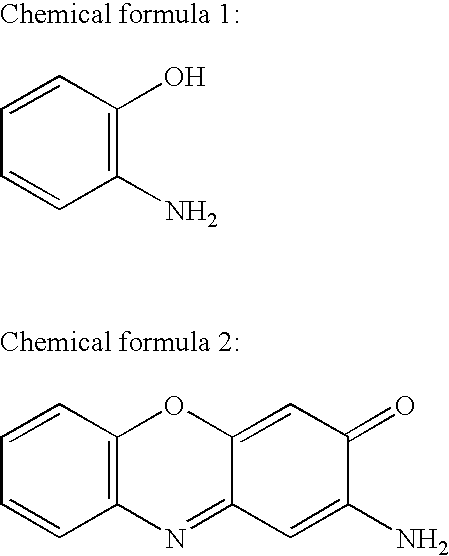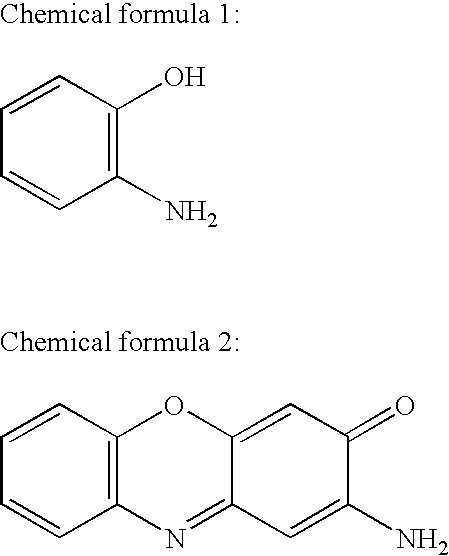Antiinflammatory agent comprising 2-aminophenol or derivative thereof as active ingredient
a technology of aminophenol and an active ingredient, which is applied in the field of antiinflammatory agents, can solve the problems of adverse side effects such as stomach ache, inflammatory responses without pathogens, and excessive inflammatory responses, and achieve the effects of inhibiting the production of melanin, reducing cytotoxicities, and reducing cytotoxicities
- Summary
- Abstract
- Description
- Claims
- Application Information
AI Technical Summary
Benefits of technology
Problems solved by technology
Method used
Image
Examples
experiment 1
Synthesis of 2-aminophenoxazine-3-one
[0026]2-Aminophenoxazine-3-one was synthesized from 2-aminophenol. Five hundred and fifty-five mg (5 mmol) of 2-aminophenol (commercialized by Wako Pure Chemical Industries, Ltd., Osaka, Japan) was suspended in 50 ml of distilled water, admixed with 225 ml of 0.1 N hydrochloric acid, and then adjusted to pH 7.0 with 0.1 N sodium hydroxide solution. The solution was admixed with 500 ml of 5 mM potassium ferricyanide aqueous solution by drops for five minutes with stirring and allowed to react at 26° C. for 30 minutes. The reaction mixture was dried under reduced pressure to give a solid, and then the solid was dissolved in 450 ml of methanol. After centrifuged to remove insoluble matters, the solution was dried under reduced pressure again. The obtained solid was dissolved in 200 ml of ethylacetate, admixed with 200 ml of 0.005 N hydrochloric acid solution, stirred, and then an ethyl acetate layer was recovered with a separatory funnel. After the ...
experiment 2
Inhibiting Activity on NO and PGEs Production by Macrophage
[0027]RAW264.7 cells, a murine macrophage cell strain, were suspended in PRMI1640 medium supplied with 10% (v / v) fetal calf serum (hereinafter abbreviated as “FCS”) to give a cell suspension with a cell concentration of 1×106 cells / ml. The suspension was inoculated to a 96-well microplate by 50 μl per well, admixed with 2-aminophenoxazine-3-one to give the final concentration of 1.6 to 100 μM, admixed with 2 μg / ml of lipopolysaccharide and 10 IU / ml of IFN-γ as inducers, then filled up to 200 μl with the above medium. After cultured at 37° C. for 2 days, the number of the living cell was counted, and then the amount of NO in each culture supernatant was measured by conventional Griess method and the amount of PGE2 was measured with “PGE2-EIA kit” (commercialized by Amersham Bioscience, Inc.) using an anti-PGE2 antibody. The comparative experiments were performed in the same way as described above using indomethacin (commercia...
experiment 3
Inhibiting Activity on COX-1 and COX-2
[0030]To verify the results of Experiment 2, it was investigated that whether the activity of COXs, essential enzymes for PGE2 synthesis system, can be inhibited. Using “COX Inhibitor Screening Assay Kit” (commercialized by Cayman Chemical Company), a reaction system containing COX-1 or COX-2 and arachidonic acid as substrate was admixed with 2-aminophenoxazine-3-one or 2-amnophenol as test samples to give the concentrations shown in Table 2 described below, and the amount of produced PGE2 was measured by E1A using an anti-PGE2 antibody to determine the COX activity. An experimental system without the test samples was set as control. The residual activity of COX-1 or COX-2 was determined as relative activity versus control. IC50 of each test sample was calculated by plotting the residual activity at each concentration of the test samples in a graph. The results are in Table
TABLE 22-Aminophenoxazine-3-one1.9 μM3.8 μM7.6 μMIC50COX-189%59%44%6.44 μ...
PUM
| Property | Measurement | Unit |
|---|---|---|
| Molar density | aaaaa | aaaaa |
| Molar density | aaaaa | aaaaa |
| Molar density | aaaaa | aaaaa |
Abstract
Description
Claims
Application Information
 Login to View More
Login to View More - R&D
- Intellectual Property
- Life Sciences
- Materials
- Tech Scout
- Unparalleled Data Quality
- Higher Quality Content
- 60% Fewer Hallucinations
Browse by: Latest US Patents, China's latest patents, Technical Efficacy Thesaurus, Application Domain, Technology Topic, Popular Technical Reports.
© 2025 PatSnap. All rights reserved.Legal|Privacy policy|Modern Slavery Act Transparency Statement|Sitemap|About US| Contact US: help@patsnap.com



